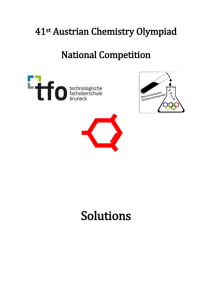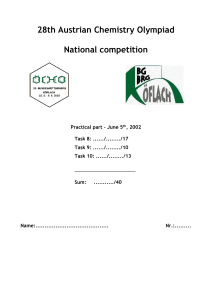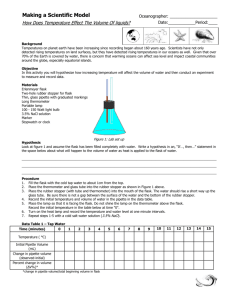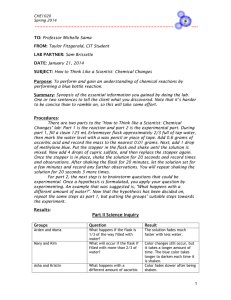Practical Examination
advertisement
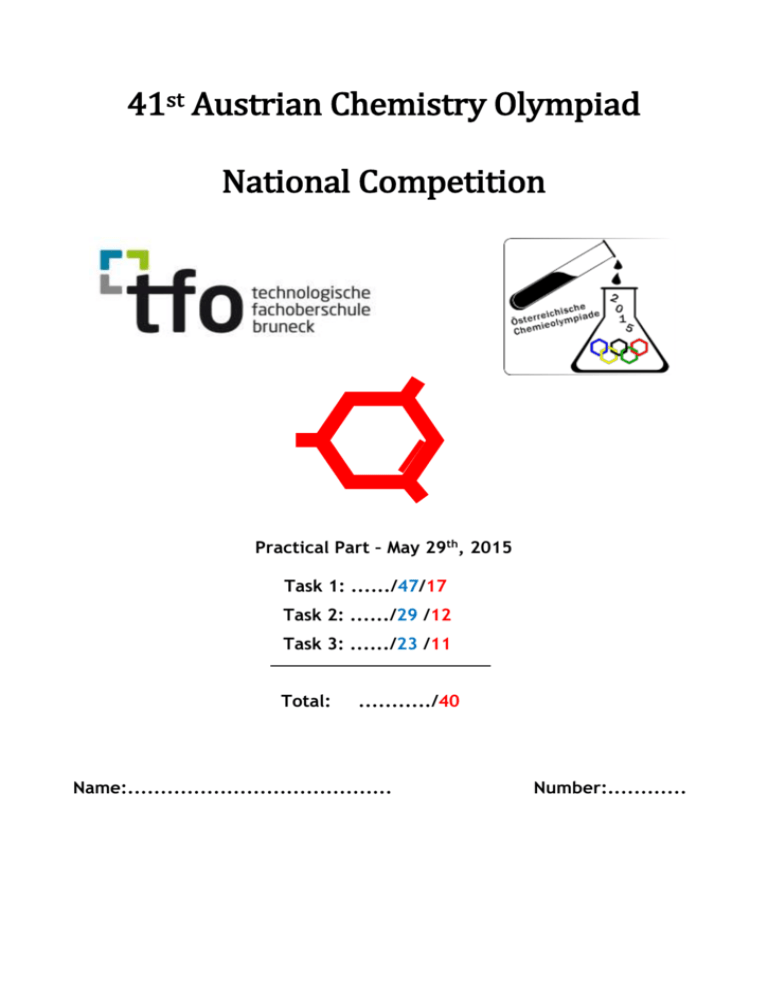
41st Austrian Chemistry Olympiad National Competition Practical Part – May 29th, 2015 Task 1: ....../47/17 Task 2: ....../29 /12 Task 3: ....../23 /11 Total: .........../40 Name:........................................ Number:............ 41st Austrian Chemistry Olympiad National Competition at the TFO Bruneck in South Tyrol Practical Part - Tasks May 29th, 2015 Hinweise You have 5 hours to complete the solutions of the competition tasks. You may only use this paper, draft paper, a not programmable calculator, a blue or black biro, a pencil, and a ruler, nothing else. Write your answers in the boxes provided for them. Only these answers will be marked. If you don’t have enough space, then you may write on the back of the pages with the remark “belongs to part x.xx“, whereby x.xx means the part of the task in italics. You may take the draft paper with you after the competition. This booklet contains 8 pages without the front page. You have to wear a lab coat and googles (or your optical glasses) all the time. For use of the spectrophotometer every competitor has a certain time frame at hand, the schedule: 9.00-9.40 9.40-10.20 10.2011.00 11.0011.40 11.4012.20 12.2013.00 Ch-Lab 1, 7 2, 8 3, 9 4, 10 5, 11 6, 12 Bi-Lab 13, 19 14, 20 15, 21 16, 22 17, 23 18, 24 Data and Formulae M (H) = 1.0 g∙mol-1 M (C) = 12 g∙mol-1 M (N) = 14 g∙mol-1 M (O) = 16 g∙mol-1 M (I) = 127 g∙mol-1 M Na) = 23.0 g∙mol-1 M (I) = 40.0 g∙mol-1 𝑚 Amount of substance 𝑛=𝑀 Molar concentration 𝑐=𝑉 Lambert-Beer’s Law 𝐴=𝜖∙𝑐∙𝑑 𝑛 1 41st Austrian Chemistry Olympiad National Competition at the TFO Bruneck in South Tyrol Practical Part - Tasks May 29th, 2015 Task 1 17 points Quantitative Analysis Freezing mixtures are made from ice and several salts. Such a salt for freezing mixtures, which contains sodium chloride and calcium chloride, was filled into your volumetric flask. In this task you should determine the composition of this freezing salt. Thereby, you will determine the total amount of chloride ions by titration with silver nitrate, the amount of calcium manganometrically. Procedure Fill up the flask in the usual way, and take out a 10.00 mL-aliquot of the homogenised sample for every determination. Determination of chloride: Pipette the aliquot into a titration flask, add about 40 mL of water (2 test tubes full) and 1 mL of 5% potassium chromate solution. Titrate with AgNO3-solution (c = 0.0500 mol/L) until the lemon yellow suspension changes to ochre. Titration volume chosen V1 = Titration equation: Equation for the indication reaction: Amount of chloride in the flask n1 = Determination of the concentration of the KMnO4-titre: Pipette 10.00 mL of the Na2C2O4-solution (0.0500 M) into a titration flask, add about 20 mL of water and 20 mL of 2 M H2SO4 (one test tube full each). Heat the solution under stirring until the display of the magnetic stirrer shows 310°C (turn of the heating now) and titrate with the KMnO4-solution (c ≈ 0.01 mol/L) the hot solution until it turns pink. The first drops will not be decolourised, because the reaction is rather slow. The Mn2+ generated although acts autocatalytically. Titration volume chosen V2 = Titration equation: concentration of the MnO4- -solution c = 2 41st Austrian Chemistry Olympiad National Competition at the TFO Bruneck in South Tyrol Practical Part - Tasks May 29th, 2015 Determination of calcium Pipette 10.00 mL of the sample solution into a 250 mL-beaker, put a glass rod into the solution and add about 40 mL of water (2 test tubes full, attention, use the test tube „H2O“).Heat the solution under stirring until the display of the magnetic stirrer shows 310°C (turn of the heating now) and add 10.00 mL of the Na2C2O4-solution (0.0500 M) drop wise. Continue stirring for another 5 minutes then filter the hot solution quantitatively into a titration flask. Add 20 mL of 2 M H2SO4 (one test tube full) to the filtrate and titrate according to the part above. Titration volume chosen V3 = amount oxalate n3 = amount CaCl2 in the flask nCaCl2 = amount NaCl in the flask nNaCl = mass CaCl2 in the flask mCaCl2 = mass NaCl in the flask mNaCl = composition in percent: 3 41st Austrian Chemistry Olympiad National Competition at the TFO Bruneck in South Tyrol Practical Part - Tasks May 29th, 2015 Task 2 12 points Photometric Analysis of a Coordination Compound General remarks - Task Iron(III)-ions form coloured complexes with thiocyanate anions. These are well known for their bloodred colour in qualitative analysis. In most cases mixtures of different complexes exist. Interestingly, at low concentrations a single species [Fe(SCN)x](3-x)+ of well defined stoichiometry exists. This compound absorbs at λ = 447 nm. At this wavelength the central atom as well as the ligands don’t have significant absorptions. To keep constant ionic strength, both salts are dissolved in diluted acid. Under these circumstances we consider only the complex formation reaction: Fe3+ + x SCN− ⇌ [Fe(SCN)x](3-x)+ disregarding H2O molecules eventually coordinated to iron. Your task is to determine x in the formula given above by means of Jobs method of continuous variation. At the same time you shall determine the formation constant K. You may use the below mentioned solutions and apparatus as well as an air displacement pipette and a photometer during the time assigned to your lab place. Take your time to carefully plan the experiment. Think in what proportions you want to mix and dilute the solutions of iron(III) nitrate and potassium thiocyanate. Measure the absorptions at 447 nm and write the results into the table and the diagram provided below. 8 1 cuvettes (PS, d = 1 cm) cuvette rack 3 1 pipette tips 1 glass bottle with 12 mL 0.2 M HNO3 rubber stopper to cap the cuvette when mixing 1 glass bottle with 12 mL KSCN 4.00 mmol/L in 0.2 M HNO3 1 glass bottle with 12 mL Fe(NO3)3 4.00 mmol/L in 0.2 M HNO3 If necessary use deionized water and paper towel from task 1. Dispose of the solutions into the sink. Please notice: The cuvettes should contain 2.00 mL in total. Use a cuvette with 0.2 M HNO3 as blank. Make as many measurements as you want. You will get 2 bp for every measurement but no more than 14 bp. You have to observe the boundary concentrations. (max. 2.40 mmol/L, min. 0.00 mmol/L of every species – see the table provided below) You can choose the mixtures for which you measure A. In the diagram you have to stick to the scaling given. 4 41st Austrian Chemistry Olympiad National Competition at the TFO Bruneck in South Tyrol Practical Part - Tasks May 29th, 2015 2.1. Fill in the concentrations and the measured absorptions. c Fe3+)/ c (SCN−)/ c (Fe3+)/ No. No. A (447nm) mmolL−1 −1 −1 mmolL 2.40 mmolL c (SCN−)/ mmolL−1 0 0 2.2. Job-Plot for the evaluation 5 2.40 A (447nm) 41st Austrian Chemistry Olympiad National Competition at the TFO Bruneck in South Tyrol Practical Part - Tasks May 29th, 2015 2.3. Stoichiometry of the complex [Fe(SCN)x](3-x)+ – as can be read from the Job-plot. x = 2.4. Calculation of the formation constant using the plot. Formation constant K = Show your calculation of K: 6 41st Austrian Chemistry Olympiad National Competition at the TFO Bruneck in South Tyrol Practical Part - Tasks May 29th, 2015 Task 3 11 points Synthesis of 2-iodobenzoic acid 1. Principle In a first step 2-aminobenzoic acid is treated with sodium nitrite in acidic solution and transformed into the corresponding diazonium salt. In the second step the diazonium group is substituted by iodide to form the desired 2-iodobenzoic acid. NO2-/H+ 2. I-/ - N2 Procedure: a) Synthesis of the crude product: Prepare an ice- bath with ice, water and sodium chloride. Use the 10 mL pipette to add 14.4 mL of H2SO4 (2,6 M H2SO4) to your 100 mL Erlenmeyer flask which already contains 2.00 g of 2-aminobenzoic acid (AS). Add a magnetic stirring bar and stir vigorously. The 2-aminobenzoic acid will not dissolve completely. Put the Erlenmeyer flask into the ice-bath, the thermometer into the suspension and control the temperature. The temperature of the reaction mixture should be between 0ᵒC and 5ᵒC. Wash your 10 mL pipette. Use it to transfer 8.8 mL of the NaNO2-solution (14% NaNO2) into the small test tube in the rack. Put the test tube into the ice- bath. When the solutions are cooled down to the required temperature, add the cold NaNO2-solution to the cooled acid using a plastic Pasteur pipette. The temperature should remain between 0ᵒC and 5ᵒC. This procedure will last between 3-5 minutes. The next two steps should be performed in the hood! Take the Erlenmeyer flask out of the ice-bath and add slowly 18.8 mL of the prepared KI-solution (26% KI), using again the 10 mL pipette. Prepare a water-bath by pouring boiling water (from an electric kettle) into the 400 mL beaker. Place the Erlenmeyer flask into the hot water-bath for at least 5 minutes (vapours of iodine may develop), then cool to room temperature under running water. The raw material will crystallise as dark brown crystals. In order to complete crystallisation the flask is placed into an ice-bath for at least 10 minutes. Stir the suspension from time to time. Filter the crude product through a Büchner funnel using suction, wash the solid carefully twice with about 10 mL of cold water. Pour the filtrate into the beaker named „organic waste“. 7 41st Austrian Chemistry Olympiad National Competition at the TFO Bruneck in South Tyrol Practical Part - Tasks May 29th, 2015 b) Recrystallisation: Put the crude product into the 100 mL beaker, add a boiling stone and 20 mL of ethanol (from the flask labelled EtOH) using the measuring cylinder. Heat the mixture on the hot-plate magnetic stirrer until boiling and the complete dissolution of the material. Add 0.6 g of activated charcoal (test tube labelled C), heat to boiling again and filter the hot mixture through a funnel with a folded paper filter into the 100 mL Erlenmeyer-flask (which you cleaned in the meantime with acetone, water und dried with paper towels). The filtrate is heated to boiling again (boiling stone!). Drop cold water to the boiling solution until the turbidity remains (about 20 mL), heat again to boiling. The solution should be clear now. Cool to room temperature slowly. Start crystallisation by scratching with a glass rod. Place the Erlenmeyer flask into the ice-bath for at least 15 minutes to complete precipitation. The product will appear as light brown crystals. Filter the product through the Büchner funnel (which has been cleaned in the meantime with acetone, water und wiped with paper towels) under reduced pressure and suck to dryness for 2 minutes. Transfer the product to a pre-weighed petri-dish and hand it over to the lab assistant for drying which will be done at 110ᵒC for 20 minutes. Ask for your product after drying. Determine yield and melting point of your product. 3.1. Hand in the product on the petri-dish: 3.2. Calculate the theoretical yield: Calculation: 3.3. Calculate your yield in g and in % of the theory: Calculation: 3.4. Melting point of your product: 8
